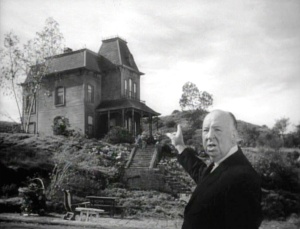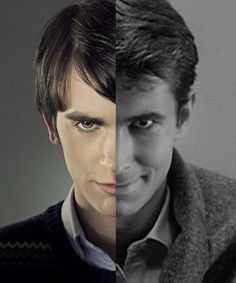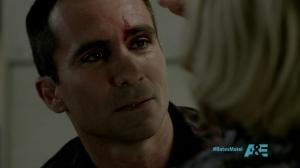 Premiering in 2013, the longest running scripted drama in the history of the Arts and Entertainment (A&E) channel is Universal Television’s Bates Motel starring Freddie Highmore, Vera Farmiga, Max Thieriot, Nestor Carbonell, and Olivia Cooke. Based on the iconic film Psycho (1960), directed by the master of suspense Alfred Hitchcock with story by Robert Bloch, Bates Motel takes us back to Norman’s early days when he was just a teenager–who was anything but normal. If you have kept up with the series, it is at a huge turning point in the character development of Norman and it just keeps getting better and better. Often shows as dark and heavy as Bates Motel do not have staying power or begin to wane after 2-3 seasons. Not this one. Just like Hitchcock’s masterpiece Psycho continues to impress, terrify, and influence even today’s suspense/horror movies, Bates Motel provides audiences with a glimpse into how Norman came to be while concurrently focussing on others who are directly and indirectly connected to the development of the most infamous psychopath in all cinema history. From visual and verbal nods even in today’s horror films to inspiring theme park attractions to television shows, the drama at Bates Motel continues to beckon audiences and intrigue those who find the characters fascinating.
Premiering in 2013, the longest running scripted drama in the history of the Arts and Entertainment (A&E) channel is Universal Television’s Bates Motel starring Freddie Highmore, Vera Farmiga, Max Thieriot, Nestor Carbonell, and Olivia Cooke. Based on the iconic film Psycho (1960), directed by the master of suspense Alfred Hitchcock with story by Robert Bloch, Bates Motel takes us back to Norman’s early days when he was just a teenager–who was anything but normal. If you have kept up with the series, it is at a huge turning point in the character development of Norman and it just keeps getting better and better. Often shows as dark and heavy as Bates Motel do not have staying power or begin to wane after 2-3 seasons. Not this one. Just like Hitchcock’s masterpiece Psycho continues to impress, terrify, and influence even today’s suspense/horror movies, Bates Motel provides audiences with a glimpse into how Norman came to be while concurrently focussing on others who are directly and indirectly connected to the development of the most infamous psychopath in all cinema history. From visual and verbal nods even in today’s horror films to inspiring theme park attractions to television shows, the drama at Bates Motel continues to beckon audiences and intrigue those who find the characters fascinating.
 Sadly, executive producer Carlton Cuse confirmed that the show’s next season is slated to be the last, and will adapt the events of the series’ namesake. Although I wish the show could go on, it is clear that we are approaching the events that started it all. That being said, this upcoming season is sure to be exciting as we get to witness the gap between where we are and where Marion Crane checks into the infamous motel begin to narrow and close. Whether we are going to end the series at the point Marion walks in or recreate the diegesis from Hitchcock’s film leaves to be seen. One of the reasons that a series like this one can even be produced is that it has prolific material from which to pull and interpret–the fact that the character of Norman Bates has been studied for years, much in the same way the film itself has been explored–provides writers and producers ample opportunity for inspiration.
Sadly, executive producer Carlton Cuse confirmed that the show’s next season is slated to be the last, and will adapt the events of the series’ namesake. Although I wish the show could go on, it is clear that we are approaching the events that started it all. That being said, this upcoming season is sure to be exciting as we get to witness the gap between where we are and where Marion Crane checks into the infamous motel begin to narrow and close. Whether we are going to end the series at the point Marion walks in or recreate the diegesis from Hitchcock’s film leaves to be seen. One of the reasons that a series like this one can even be produced is that it has prolific material from which to pull and interpret–the fact that the character of Norman Bates has been studied for years, much in the same way the film itself has been explored–provides writers and producers ample opportunity for inspiration.
 Since we are given little information about Norman in the movie–note: that does nothing to mitigate the experience or effectiveness of the plot–his childhood to adolescent years and transition into adulthood is open for interpretation. For many years, film scholars like myself and others have often hypothesized what psychological and emotional experiences plagued Norman and affected his development. It would be all too easy and even a copout to state that he simply suffers a psychological disorder that was present when he was born. What I appreciate about the show’s portrayal of Norman is taking the cognitive and emotional atypical condition he was likely born with and throwing other experiences into the mix. It’s nature v nurture on a whole new level. Through the storytelling of Bates Motel, we have witnessed how his upbringing has had a profound impact on his development into the single most famous psychopath in cinema and now television history.
Since we are given little information about Norman in the movie–note: that does nothing to mitigate the experience or effectiveness of the plot–his childhood to adolescent years and transition into adulthood is open for interpretation. For many years, film scholars like myself and others have often hypothesized what psychological and emotional experiences plagued Norman and affected his development. It would be all too easy and even a copout to state that he simply suffers a psychological disorder that was present when he was born. What I appreciate about the show’s portrayal of Norman is taking the cognitive and emotional atypical condition he was likely born with and throwing other experiences into the mix. It’s nature v nurture on a whole new level. Through the storytelling of Bates Motel, we have witnessed how his upbringing has had a profound impact on his development into the single most famous psychopath in cinema and now television history.
 The show is not limited to the development and history of Norman, but also includes influential people in his life. Of course there’s Mother (Norma), but we also have grown to love his estranged brother Dylan, close friend Emma, and frienemy Sheriff Romero. Obviously Norman is obviously interesting to watch, but the writers and producers of the show make sure that each of the principle and reoccurring characters are fascinating as well. Dylan represents the only male figure in Norman’s life who consistently tries to help him, even though Norman often cannot see the love in his brother’s actions. Much like Norman, Dylan has also encountered much negativity and abandonment issues as a kid. Unlike Norman though, he found ways to deal with it and build a life for himself. In recent times, Norman keeps pushing the one positive male role model in his life away to further isolate himself. His close friend and coworker Emma is a very interesting female figure in his life. Unlike Mother or other females we have encountered over the series, he loves Emma and has done nothing to bring about permanent harm to her–at least so far. Emma is the only person who really gets to see the Norman hidden behind all his bizarre actions and obsession with Mother. Like Norman and Dylan, Emma had her own struggles with cystic fibrosis. Each of the characters is dealing with their own respective psychological or physical problems.
The show is not limited to the development and history of Norman, but also includes influential people in his life. Of course there’s Mother (Norma), but we also have grown to love his estranged brother Dylan, close friend Emma, and frienemy Sheriff Romero. Obviously Norman is obviously interesting to watch, but the writers and producers of the show make sure that each of the principle and reoccurring characters are fascinating as well. Dylan represents the only male figure in Norman’s life who consistently tries to help him, even though Norman often cannot see the love in his brother’s actions. Much like Norman, Dylan has also encountered much negativity and abandonment issues as a kid. Unlike Norman though, he found ways to deal with it and build a life for himself. In recent times, Norman keeps pushing the one positive male role model in his life away to further isolate himself. His close friend and coworker Emma is a very interesting female figure in his life. Unlike Mother or other females we have encountered over the series, he loves Emma and has done nothing to bring about permanent harm to her–at least so far. Emma is the only person who really gets to see the Norman hidden behind all his bizarre actions and obsession with Mother. Like Norman and Dylan, Emma had her own struggles with cystic fibrosis. Each of the characters is dealing with their own respective psychological or physical problems.
 Lastly, prior to analyzing Norma, Sheriff Romero has played a key role in the life of Norman. Like Dylan he too is a consistent male figure in his life, but Norman has grown to resent Romero for his relationship with Norma. Romero has worked through his involvement in the drug trade and has grown as a result of it. Again, we have an individual with their own personal conflicts amidst the consistent conflict of Norman. The only other character, besides Dylan, who really knows what Norman is capable of. Romero is constantly trying to protect Norma from what he dreads Norman is truly capable of.
Lastly, prior to analyzing Norma, Sheriff Romero has played a key role in the life of Norman. Like Dylan he too is a consistent male figure in his life, but Norman has grown to resent Romero for his relationship with Norma. Romero has worked through his involvement in the drug trade and has grown as a result of it. Again, we have an individual with their own personal conflicts amidst the consistent conflict of Norman. The only other character, besides Dylan, who really knows what Norman is capable of. Romero is constantly trying to protect Norma from what he dreads Norman is truly capable of.
 “Mother, what have you done?!?” Norma Bates is probably the most fascinating character after Norman. She is the closest to him and has been directly and indirectly responsible for his atypical development from his time as a child into an adult. Although she all but denies Norman’s psycho-social and emotional problems, she truly does recognize they exist. Unfortunately, she is so incredibly attached to him, having been abused and abandoned herself in the past, that she cannot truly provide the help he needs. Fortunately, she finally got him the help he needed–and should’ve received years prior–at the Pine View facility as we have seen in this season. It’s too little help too late. For the longest time, she felt that mother knew best and that no one could help Norman the way she could. Oh the irony. The attachment she was so fond of is regrettably the very thing that would bring about her undoing. Despite her best intentions, she really was the most instrumental in creating a monster. Her fits of rage and jealousy transferred into the mind of Norman and intensified the predisposition to sociopathic behaviors already present. Had she taken him to get help as a child, it is entirely possible that he may not have turned out to be the “psycho” after all. But, mother will always be with Norman; and no woman is allowed to take the place of her in his life.
“Mother, what have you done?!?” Norma Bates is probably the most fascinating character after Norman. She is the closest to him and has been directly and indirectly responsible for his atypical development from his time as a child into an adult. Although she all but denies Norman’s psycho-social and emotional problems, she truly does recognize they exist. Unfortunately, she is so incredibly attached to him, having been abused and abandoned herself in the past, that she cannot truly provide the help he needs. Fortunately, she finally got him the help he needed–and should’ve received years prior–at the Pine View facility as we have seen in this season. It’s too little help too late. For the longest time, she felt that mother knew best and that no one could help Norman the way she could. Oh the irony. The attachment she was so fond of is regrettably the very thing that would bring about her undoing. Despite her best intentions, she really was the most instrumental in creating a monster. Her fits of rage and jealousy transferred into the mind of Norman and intensified the predisposition to sociopathic behaviors already present. Had she taken him to get help as a child, it is entirely possible that he may not have turned out to be the “psycho” after all. But, mother will always be with Norman; and no woman is allowed to take the place of her in his life.
 Well, here we are! At the crossroads between seasons four and five. This upcoming season is sure to terrify and excite as we buildup to the single most famous scene in all of cinema history. The reason the shower scene is the single most famous scene can be recognized by analyzing the length, actions, and sounds included in those few seconds. You can learn more about that scene by reading my article The “Attraction” of Horror: a “Psycho”analysis. After more than 50 years, the Bates Motel and Norman still haunt our dreams and provide direction and inspiration for today’s cinematic storytellers. An interesting thought on the direction of these immortal characters and setting is the potential for a live theatrical production. There is certainly enough dialog driven material that Psycho and Bates Motel can easily be translated into a live theatre experience. It takes rich material to be able to be so versatile. Here’s to the final season of A&E and Universal Television’s five year homage to the infamous and macabre happenings at the Bates Motel. Thank you Hitchcock for truly being the master of suspense.
Well, here we are! At the crossroads between seasons four and five. This upcoming season is sure to terrify and excite as we buildup to the single most famous scene in all of cinema history. The reason the shower scene is the single most famous scene can be recognized by analyzing the length, actions, and sounds included in those few seconds. You can learn more about that scene by reading my article The “Attraction” of Horror: a “Psycho”analysis. After more than 50 years, the Bates Motel and Norman still haunt our dreams and provide direction and inspiration for today’s cinematic storytellers. An interesting thought on the direction of these immortal characters and setting is the potential for a live theatrical production. There is certainly enough dialog driven material that Psycho and Bates Motel can easily be translated into a live theatre experience. It takes rich material to be able to be so versatile. Here’s to the final season of A&E and Universal Television’s five year homage to the infamous and macabre happenings at the Bates Motel. Thank you Hitchcock for truly being the master of suspense.

One of my favorite show
LikeLiked by 1 person
Pingback: All the Horror: Women in Horror Month 2020 | The R.L. Terry ReelView